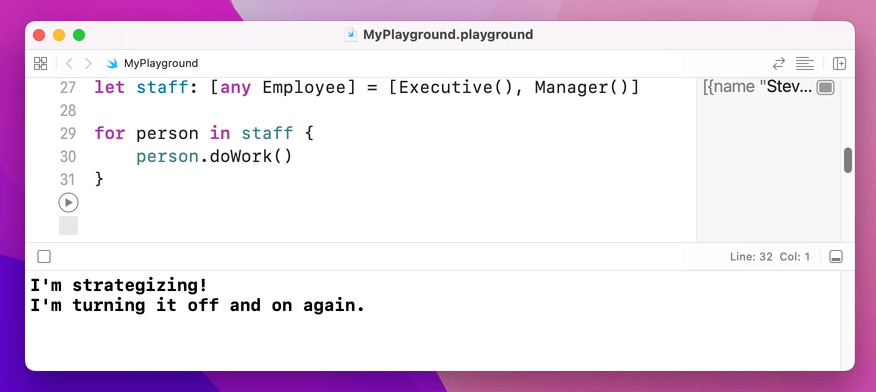Protocols
Protocols are effectively contracts in Swift: they define a set of methods and properties that a type must implement if it says it conforms to the protocol. This contract gives us the flexibility to use different types to solve the same problem – we don’t get whether a ThingA or a ThingB is being used, as long as they both conform to the Thing protocol.
As an example, an Employee protocol might look like this:
protocol Employee {
var name: String { get set }
var jobTitle: String { get set }
func doWork()
}There are three important things in there.
First, both the properties have { get set } after them. This means that conforming types must make them both gettable (readable) and settable (writeable), which in turn means if a type says it is compatible with the Employee protocol it must make those two properties variables rather than constants.
Second, doWork() has no code inside it. Protocols are contracts defining how something ought to be able to behave, and don’t provide implementations of those behaviors.
Third, that protocol isn’t a concrete type, which means we can’t create instances of it. But we can create classes and structs that conform to it, like this:
struct Executive: Employee {
var name = "Steve Jobs"
var jobTitle = "CEO"
func doWork() {
print("I'm strategizing!")
}
}
struct Manager: Employee {
var name = "Maurice Moss"
var jobTitle = "Head of IT"
func doWork() {
print("I'm turning it off and on again.")
}
}Now that we have a protocol and two types that conform to it, we can try using it:
let staff: [any Employee] = [Executive(), Manager()]
for person in staff {
person.doWork()
}
Because both types conform to Employee – they implement the properties and methods of that protocol – we can create an employee array and use the objects inside that array without knowing what their actual type is.
Notice how we use [any Employee] rather than just [Employee] – this is Swift’s way of making it clear in our code that the actual data types inside the array could be anything at all, as long as it conforms to the Employee protocol.

SPONSORED Join a FREE crash course for mid/senior iOS devs who want to achieve an expert level of technical and practical skills – it’s the fast track to being a complete senior developer! Hurry up because it'll be available only until April 28th.
Sponsor Hacking with Swift and reach the world's largest Swift community!


















